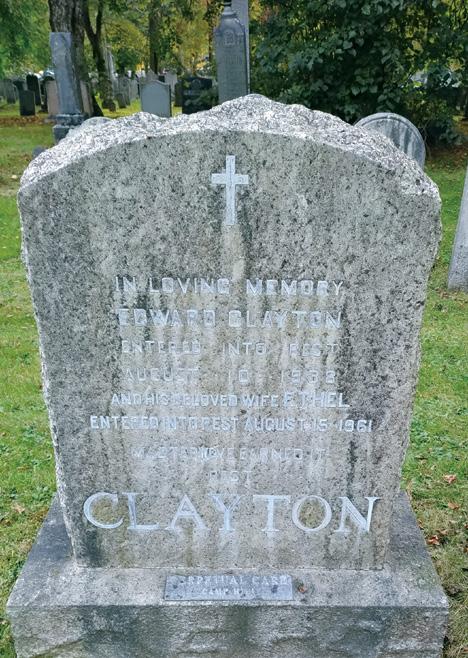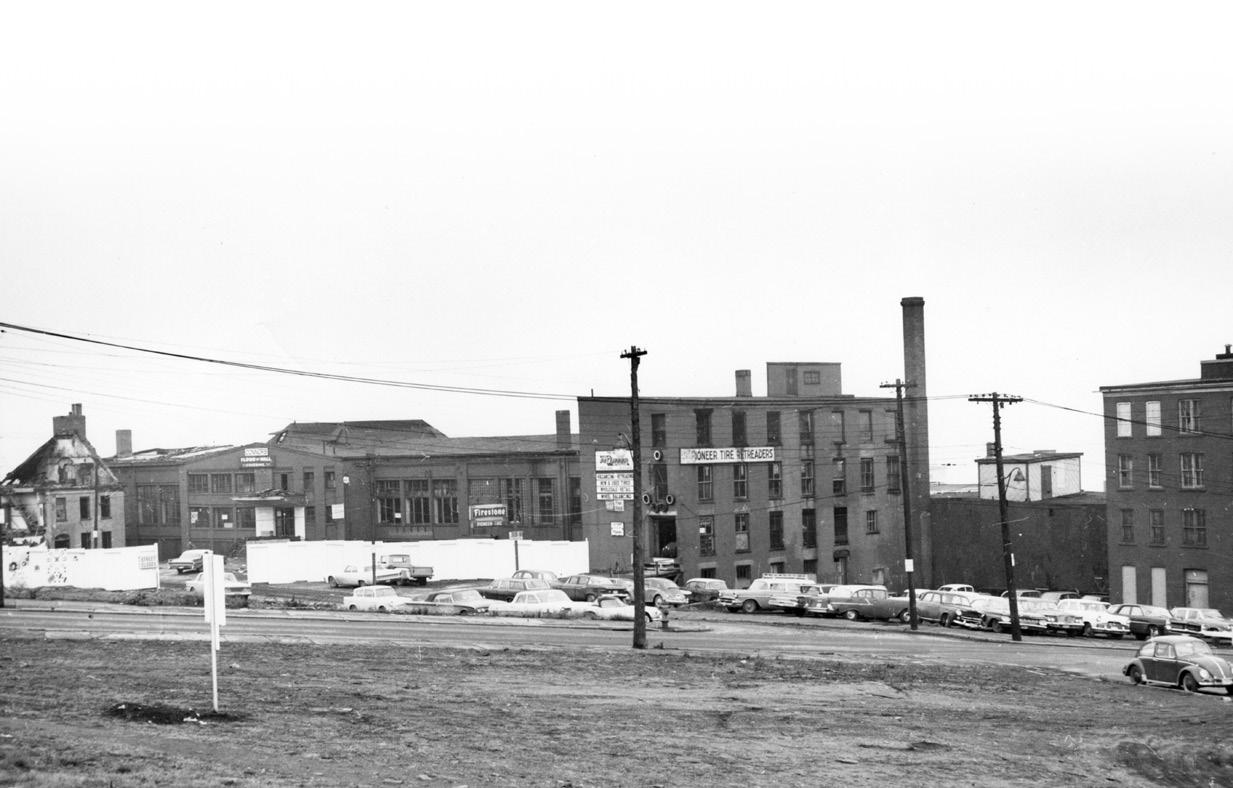
6 minute read
THE BACKSTORY
A name that shaped HALIFAX
Clayton was once just a name on a clothing business — as the family’s fortunes ebbed and flowed, they helped shape their city
BY KATIE INGRAM
Their name is well-known to Haligonians, but the Clayton family’s history in the city stretches back long before the sprawling development that bears their name.
The family’s influence on the city began far from Clayton Park. On the site that now houses Scotia Square, Clayton & Sons, a clothing manufacturer, was a Halifax mainstay for almost a century, one that started with a small second-hand clothing store on Duke Street.
Originally from England, Mary and George Clayton immigrated to Nova Scotia with their eight children in 1863. The next year, George, who worked as a tailor, died from a stroke.
“He died rather quickly and unexpectedly,” says Erika Wilson, curator of collections at the Nova Scotia Museum of Industry. “They had quite a few children and his widow, Mary was left to try and come up with a way to support her family.”
By 1866, Mary had established her second-hand clothing shop out of the family home on Duke Street. Over the next 30 years, under her leadership and that of her sons Edward and William, Claytons would grow.
“They did open one of the city’s biggest, most progressive industries,” says Wilson.
They offered workers profit sharing and banking options. Their factory, located on the corner of Barrington and Jacob streets, was recognized for its well-lit and clean conditions. At its busiest, it employed about 500 people.
By the late 1890s, the factory housed everything the business needed under one roof including two work rooms, a special order department, a clothing and furnishing stock rooms, a cutting room, and a packing and shipping room.
According to a booklet celebrating the company’s 30th anniversary, Claytons was a name that was “synonymous with the growth of the clothing trade in Canada ... The firm stands in the front rank.”
By the 1930s, the company was no longer so progressive. Reports suggest the factory wasn’t as clean and appealing as it once was, and the company was losing money. William and Edward died during this decade, with William’s daughter Mary Louise taking over.
“The company wasn’t really keeping up with the fashions and trends at the time; they were more kind of focusing on ready-made pieces that they had been making for a while,” says Wilson. “Another reason was that they had kind of shifted focus into making uniforms, especially for the military. After the Second World War, they had had a huge contract … that had fallen through and so they had lost quite a bit of money in that venture.”
By 1955, to avoid having to file for bankruptcy, Claytons closed. The factory building was demolished in the 1960s.
Yet the family name would return to play a big part in Halifax’s future. In the family’s turn-of-the-century heyday, they bough a sprawling tract of land in Rockingham. After their fortunes shifted in the late 1950s, they sold the 40 hectares to a developer. From that, grew Clayton Park, one of the city’s fastest-growing neighbourhoods over the last two decades.
TIMELINE
Jean Holder Nova Scotia Archives 1980-195 no. 24 / neg. no.: N-0172

While it looks Dickensian today, Clayton & Sons was a remarkably progressive business in its 19th-century heyday, even sharing profits with workers • May23,1819: Mary Clayton (nee Davies) was born in
Bishop’s Castle, Shropshire, England.
• March 22, 1844: Mary marries George Clayton, a tailor from her hometown.
• 1863: The Claytons, now with eight children, immigrate to Nova Scotia.
• Dec.24,1864: George dies, leaving Mary to raise and provide for their children.
• 1866: Mary’s second hand-clothing business is registered in the Halifax City Directory.
• 1869: The first shop, separate from the family home, opens on Argyle Street. At this time, the business is known as M. Clayton & Sons Tailors and Clothiers. It’s unclear when the family moved from second-hand clothing to manufacturing.
• 1875: Clayton & Sons moves to Jacob Street. Over the next 50 years, the company would expand, as did the family’s ownership of buildings in now-razed downtown neighbourhood. • 1880–1881: The Halifax City Directory lists Mary as
Mary Clayton, widow of George. It previously listed her as Mrs. Mary Clayton of M. Clayton & Sons, leading to the assumption she had retired from the business. By this time, sons George and William were active in the company.
• 1891: The family now owns much of the land between Jacob and Birmingham streets and starts building a new factory.
• 1895: The new factory, at the corner of Jacob and
Barrington streets, opens.
• 1895: Claytons starts a savings bank for workers.
Deposits could be as low as five cents, which would then see a return with an interest of four per cent.
• 1897: A fire severely damages the factory and causes a power outage in downtown Halifax. Using their insurance money, the company buys 90 new sewing machines.

Nova Scotia Museum Katie Ingram

• 1899: The Claytons introduce a profit-sharing option for workers. Ten per cent of future profits would be divided among participating workers with an interest rate of seven per cent. The 10 per cent would be divvied among workers, based on job type.
First-class workers would get 40 per cent of the allotted profits, while the fourth class would receive 10 per cent.
• Early 1900s: George and William start buying more land in the Rockingham area. The family would eventually own over 40 hectares.
• February1907: Mary dies.
• Dec. 6, 1917: The Halifax Explosion damages the factory.
• 1935: William dies.
• 1938: Edward dies.
• 1950s: Claytons incorporates as Claytons Ltd. with three shareholders: William’s daughter Mary Louise,
A.D. Walker, and C.F. MacKenzie.
• 1955: Clayton & Sons closes.
• Post-1955: The Clayton buildings would remain listed in the city directories until 1959, housing various tenants. • Late 1950s–early 1960s: Mary Louise starts selling the family’s real estate holdings, a process that continues for the next few years. The family sells its
Rockingham land to a developer, who starts working in 1962 on a project known today as Clayton Park.
• 1968: Jacob Street and its buildings are demolished to make way for Scotia Square. Its construction begins in 1970.
• 1974: Mary Louise dies.
• 1978: Dunbrack Street opens, giving better access to the Clayton Park area, previously only reachable via the Bedford Highway.
• 1991: The original Lacewood bus terminal near
Willet Street opens.
• 1997–2003: The area of Clayton Park West is added to
Clayton Park, bringing new housing and commercial developments.
• 1999: Thrush Hermit, a Canadian rock band featuring Joel Plaskett, releases their second album, titled
Clayton Park.
• 2013: The Willet Street Reserve in the Clayton Park area is renamed Mary Clayton Memorial Park.
Robert Alfers
Clayton & Sons, on the site Scotia Square now occupies. Mary Clayton’s gravestone stands in Camp Hill cemetery on Summer Street.






